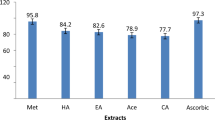Abstract
The application of natural antimutagens and antioxidants, particularly those derived from higher plants has been seen as a promising approach to the protection of human health. In this work, we studied methanolic extracts from Sansevieria cylindrica, Sansevieria trifasciata, and Polianthes tuberosa plants focusing on their antioxidative and antimutagenic capacities based on the following parameters: inhibitory activity on lipid peroxidation, suppressing ability on direct-acting mutagen sodium azide-induced mutagenesis in Salmonella typhimurium cells. A clear dose-dependent decrease in lipid peroxidation was observed with all the extracts tested. Extracts from leaves of P. tuberosa and rhizomes of S. cylindrica and S. trifasciata (1 mg/mL) displayed the highest antioxidant effect. At the same time, extracts from rhizomes of S. cylindrica and S. trifasciata significantly reduced the sodium azide-induced mutations. The highest antimutagenic activity (76 %) in the S. typhimurium TA100 strain was obtained for the S. cylindrica rhizomes extract (1 mg/plate). We propose that the observed protective effects of plant extracts tested may correspond to a synergic participation of several secondary metabolites and mainly to polyphenolic compounds.


Similar content being viewed by others
References
Liou, G. Y., & Storz, P. (2010). Reactive oxygen species in cancer. Free Radical Research, 44, 479–496.
Zhang, P. Y., Xu, X., Li, X. C. (2014). Cardiovascular diseases: oxidative damage and antioxidant protection. European Review for Medical and Pharmacological Sciences, 20, 3091–3096.
Bayani, U., Ajay, V. S., Zamboni, P., Mahajan, R. T. (2009). Oxidative stress and neurodegenerative diseases: a review of upstream and downstream antioxidant therapeutic options. Current Neuropharmacology, 7, 67–74.
Finkel, T. (2003). Oxidant signals and oxidative stress. Current Opinion in Cell Biology, 15, 247–254.
Jena, N. R. (2012). DNA damage by reactive species: Mechanisms, mutation and repair. Journal of Biosciences, 37, 503–517.
Lachumy, S., Zuraini, Z., Sasidharan, S. (2010). Antimicrobial activity and toxicity of methanol extract of Cassia fistula seeds. RJPBCS, 1, 391–398.
Aust, S. D. (1985). Lipid peroxidation. In R. A. Greenwald (Ed.), Handbook of methods for oxygen radical research (pp. 203–207). Boca Raton: CRC Press.
Maron, D. H., & Ames, B. N. (1983). Revised methods for the Salmonella typhimurium mutagenicity test. Mutation Research, 113, 173–215.
Negi, P. S., Jayaprakasha, G. K., Jena, B. S. (2003). Antioxidant and antimutagenic activities of Promegranate peel extracts. Food Chemistry, 80, 393–397.
Maiti, S., Moon, U., Bera, P., Samanta, T., Mitra, A. (2015). The in vitro antioxidant capacities of Polianthes tuberosa L. flower extracts. Acta Physiologiae Plantarum, 36, 2597–2605.
Almaraz-Abarca, N., Delgado-Alvarado, E. A., Ávila-Reyes, J. A., Uribe-Soto, J. N., González-Valdez, L. S. (2013). The phenols of the genus Agave (Agavaceae). Journal Biomater Nanobiotechnol, 4, 9–16.
Acknowledgments
This work was supported by the Russian Foundation for Basic Research (RFBR, grant number 15-54-61024), the program of competitive growth of Kazan Federal University, the subsidy allocated to Kazan Federal University for the state assignment in the sphere of scientific activities, and by the Science and Technology Development Fund, Egypt (STDF, grant number 13821).
Author information
Authors and Affiliations
Corresponding author
Rights and permissions
About this article
Cite this article
Karamova, N., Gumerova, S., Hassan, G.O. et al. Antioxidant and Antimutagenic Potential of Extracts of Some Agavaceae Family Plants. BioNanoSci. 6, 591–593 (2016). https://doi.org/10.1007/s12668-016-0286-x
Published:
Issue Date:
DOI: https://doi.org/10.1007/s12668-016-0286-x




